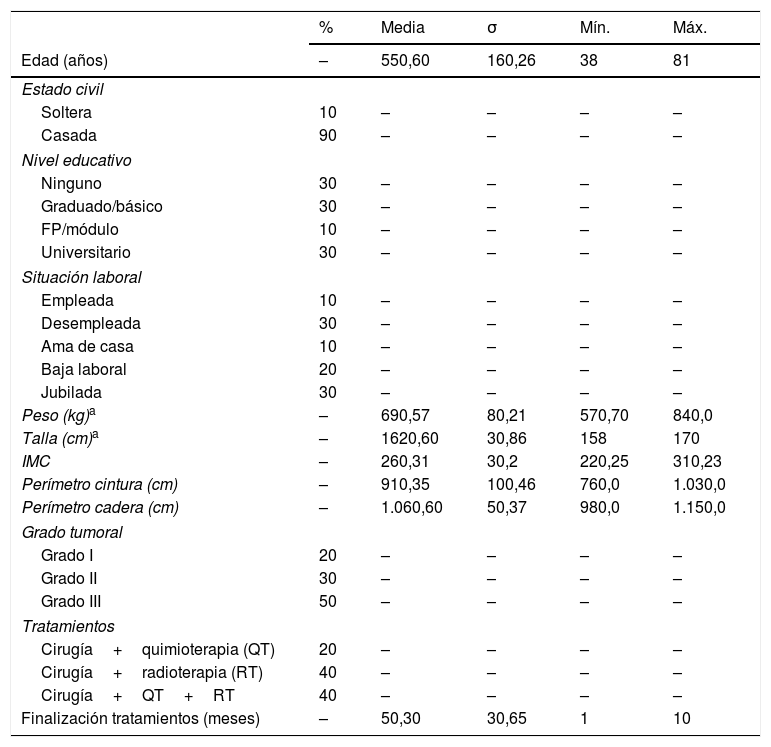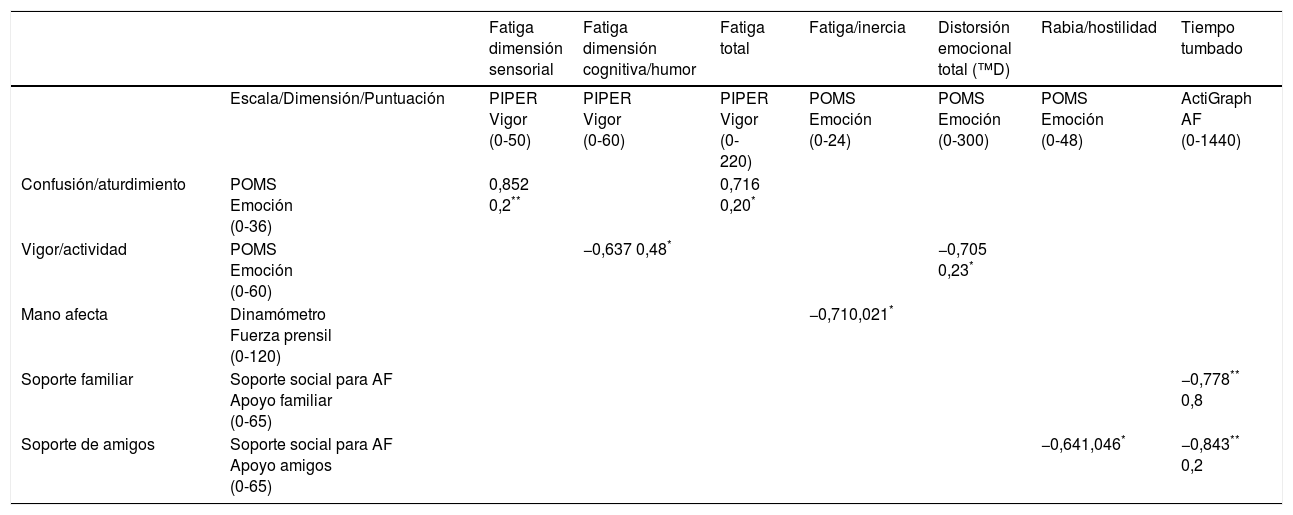Analizar el grado de acuerdo entre la medida autoinformada provista por el International Physical Activity Questionnaire (IPAQ) y la medida objetiva aportada por los acelerómetros (ActiGraph) en mujeres supervivientes a un cáncer de mama.
Objetivo secundarioEvaluar la percepción de sensación de fatiga de estas pacientes, así como su estado de ánimo y la fuerza prensil. También quisimos comprobar la relación entre el soporte social y la práctica de actividad física.
Material y métodoLas 10 participantes llevaron un acelerómetro 9 días y a su retirada completaron los cuestionarios IPAQ, PIPER, POMS, uno de valoración de su soporte social y se tomaron medidas de la dinamometría de ambas manos. Se procedió al análisis inferencial usando el coeficiente de correlación de Spearman (rs) entre la AF total y las diferentes categorías por intensidad contabilizada por el ActiGraph, y la recogida por el IPAQ. Los datos fueron comparados en min/día realizando actividad sedentaria, ligera, moderada o intensa.
ResultadosNo se encontró concordancia entre los datos arrojados por ambos instrumentos, a excepción de la categoría sedentaria/sentado, con un rs=0,714 (p=0,02). Los minutos/día totales de AF del acelerómetro ha sido un 263% más elevados que del cuestionario, por lo que este último infravalora la AF. Respecto a las dimensiones emocionales evaluadas, la confusión/aturdimiento se relacionó significativamente con la sensación de fatiga (rs=0,85, p=0,002) y la fatiga total (rs=0,71, p=0,02). También apareció una relación inversa entre vigor/actividad y la dimensión cognitiva de la fatiga (rs=–0,63, p=0,04). La sensación de fatiga/inercia también se relacionó inversamente con la fuerza prensil de la mano del lado intervenido. También fue inversa la relación entre el soporte familiar y de amigos y el tiempo en posición tumbado o en decúbito (rs=–0,77, p=0,008 y rs=–0,84, p=0,002, respectivamente) y entre este apoyo de los amigos y la rabia/hostilidad (rs=–0,64, p=0,04)
ConclusionesHabía un grado de acuerdo limitado en la medida de la AF y las conductas sedentarias del IPAQ y del Actigraph. El primero no parece ser muy adecuado para esta población, y para el acelerómetro necesitaríamos valores de referencia más en consonancia con estas mujeres.
To analyse the level of agreement between that measured by the self-report provided by the IPAQ (International Physical Activity Questionnaire) and the objective measurement provided by accelerometers (ActiGraph) in breast cancer patients.
Secondary objectiveTo evaluate the perception of their fatigue in these patients, as well as their state of mind and prehensile strength. An attempt was also made to determine the relationship between social support and the practice of physical activity.
Material and methodThe 10 patients carried an accelerometer for 9 days, and afterwards they completed the IPAQ, Piper Fatigue Scale (PFS), and Profile of Mood States (POMS) questionnaires. Their social support was also assessed, and dynamometry measurements were taken on both hands. An inferential analysis was performed using the Spearman correlation coefficient (rs) between the total physical activity (PA) and the different categories by the intensity measured by ActiGraph, and that recorded in the IPAQ. The data were compared in minutes/day of sedentary, light, moderate or intense activity.
ResultsNo agreement was found between the data provided by both tools, with the exception of the sedentary/seated category with a Spearman coefficient (rs) of 0.714 (P=.02). The total minutes/day of the accelerometer was 263% higher than the questionnaire, thus this latter undervalued the PA. As regards the emotional dimensions evaluated, confusion/bewilderment was significantly associated with feeling of fatigue (rs=0.85, P=.002), and total fatigue (rs=0.71, P=.02). An inverse relationship was also observed between vigour/activity and cognitive dimension of fatigue (rs=–0.63, P=.04). The feeling of fatigue/inertia was also inversely associated with prehensile strength of the hand on the side of the intervention. There was also an inverse relationship between family and friends support and the time in the lying down or decubitus position (rs=–0.77, P=.008 and rs=–0.84, P=.002, respectively) and between this support by friends and anger/hostility (rs=–0.64, P=.04)
ConclusionsThere was a limited level of agreement in the measurement of PA and sedentary behaviours of the IPAQ and Actigraph. The first one does not seem to very suitable for this population, and reference values more in line with these women are needed for the accelerometer.
Artículo
Si ya tiene sus datos de acceso, clique aquí.
Si olvidó su clave de acceso puede recuperarla clicando aquí y seleccionando la opción "He olvidado mi contraseña".Comprando el artículo el PDF del mismo podrá ser descargado
Precio 19,34 €
Comprar ahora












